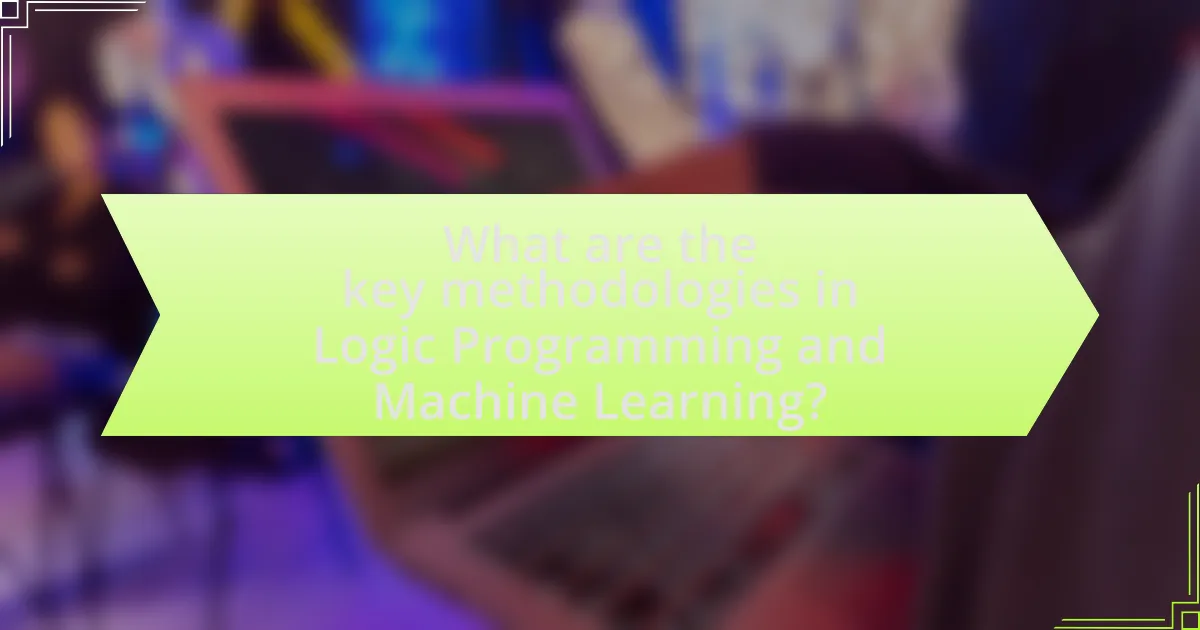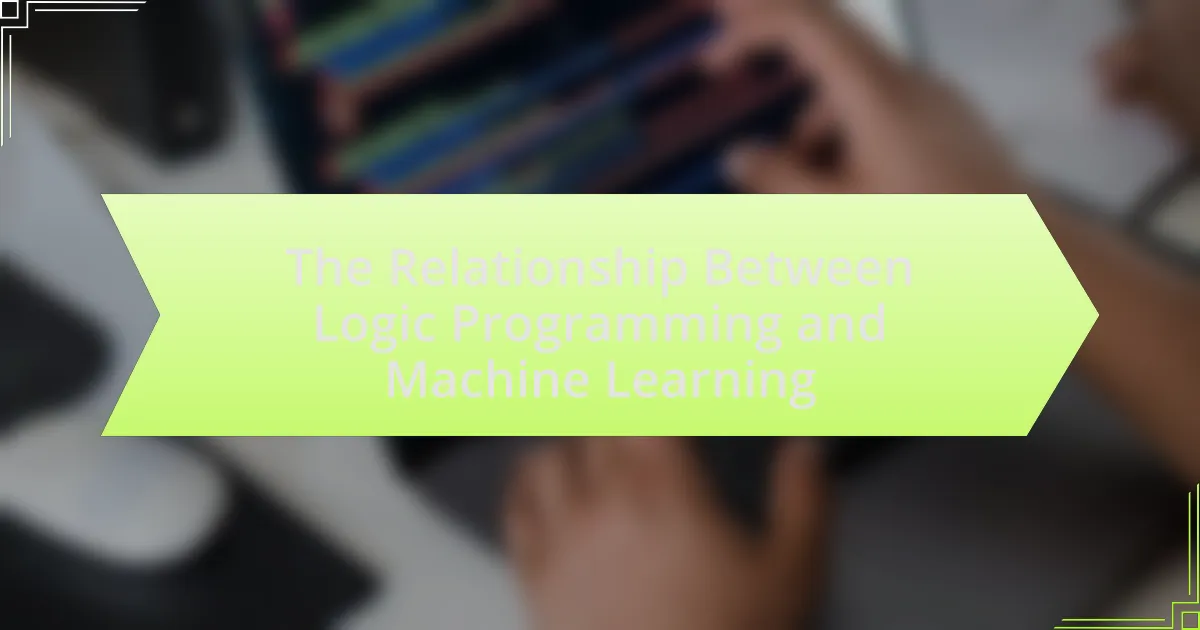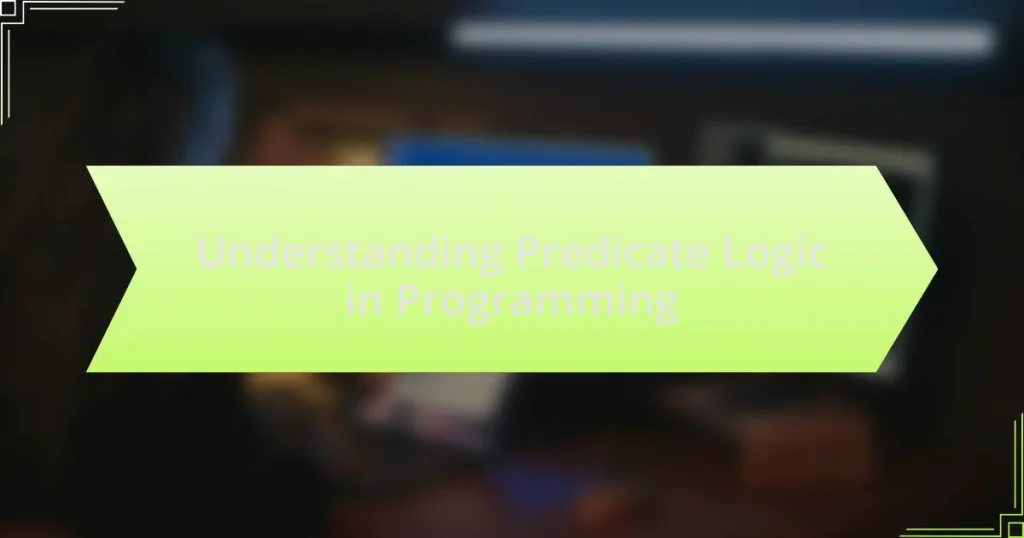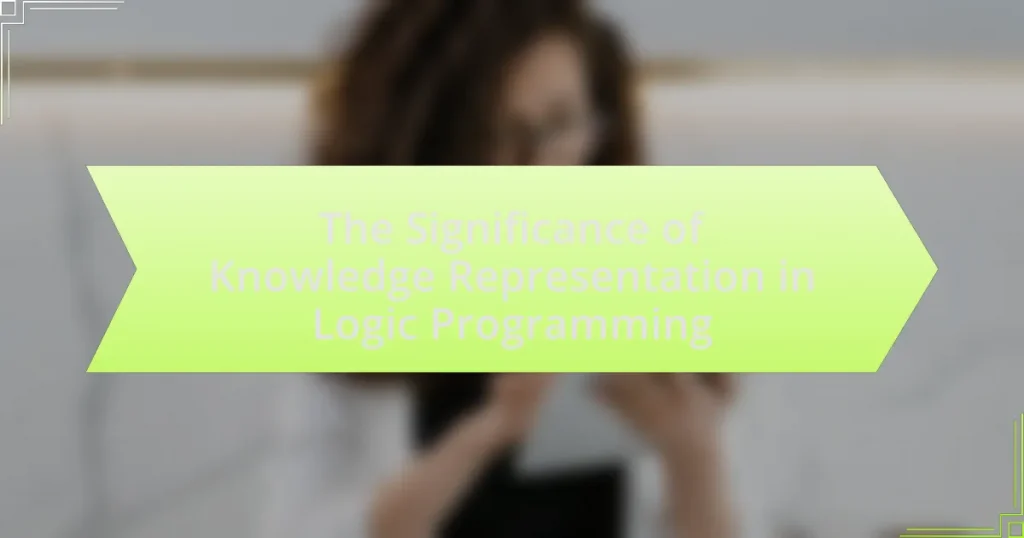The article explores the relationship between logic programming and machine learning, highlighting their interconnectedness in facilitating intelligent decision-making and problem-solving. It discusses how logic programming provides a formal framework for knowledge representation and reasoning, which can enhance machine learning algorithms’ capabilities. Key methodologies, foundational principles, and practical applications are examined, including the integration of inductive logic programming and the challenges faced in merging these two fields. The article emphasizes the importance of this relationship for future technologies and innovation across various industries, ultimately enhancing decision-making processes and problem-solving capabilities.

What is the Relationship Between Logic Programming and Machine Learning?
Logic programming and machine learning are interconnected fields that both aim to facilitate intelligent decision-making and problem-solving. Logic programming provides a formal framework for representing knowledge and reasoning, often using rules and facts, which can be beneficial for structuring data in a way that machine learning algorithms can utilize. For instance, Prolog, a prominent logic programming language, allows for the creation of complex rule-based systems that can be enhanced with machine learning techniques to improve their predictive capabilities. This synergy is evident in approaches like Inductive Logic Programming (ILP), which combines logic programming with inductive reasoning to learn logical rules from examples, demonstrating the practical integration of both domains.
How do Logic Programming and Machine Learning intersect?
Logic programming and machine learning intersect primarily through the integration of logical reasoning with data-driven learning methods. Logic programming provides a formal framework for representing knowledge and reasoning, while machine learning focuses on extracting patterns from data. This intersection is evident in approaches like Inductive Logic Programming (ILP), which combines logic programming’s declarative nature with machine learning’s ability to generalize from examples. ILP allows for the creation of hypotheses in the form of logic programs based on observed data, effectively bridging the gap between symbolic reasoning and statistical learning. This synergy enhances the capabilities of both fields, enabling more robust models that can reason about complex relationships while learning from empirical data.
What are the foundational principles of Logic Programming?
The foundational principles of Logic Programming include the use of formal logic as a programming paradigm, where programs are expressed in terms of relations and rules. Logic Programming is based on the concepts of facts, rules, and queries, allowing for declarative problem-solving. The primary proof of its validity lies in its mathematical foundation, particularly in first-order predicate logic, which enables automated reasoning and inference. This framework allows for the creation of programs that can derive conclusions from given facts and rules, exemplified by languages such as Prolog, which utilize these principles to facilitate logical reasoning and problem-solving.
What are the foundational principles of Machine Learning?
The foundational principles of Machine Learning include supervised learning, unsupervised learning, reinforcement learning, and feature extraction. Supervised learning involves training a model on labeled data to make predictions, while unsupervised learning identifies patterns in unlabeled data. Reinforcement learning focuses on training agents to make decisions through trial and error in an environment. Feature extraction is the process of transforming raw data into a format suitable for modeling. These principles are essential for developing algorithms that can learn from data and improve over time, as evidenced by their application in various domains such as image recognition and natural language processing.
Why is understanding this relationship important?
Understanding the relationship between logic programming and machine learning is important because it enhances the development of intelligent systems that can reason and learn from data. Logic programming provides a formal framework for representing knowledge and reasoning, while machine learning algorithms excel at identifying patterns in large datasets. This synergy allows for the creation of systems that not only learn from examples but also apply logical reasoning to make informed decisions. For instance, integrating logic programming with machine learning can improve the interpretability of models, as seen in research by Muggleton and De Raedt, which demonstrates how logic-based approaches can enhance the transparency of machine learning outcomes.
How can this relationship enhance problem-solving capabilities?
The relationship between logic programming and machine learning enhances problem-solving capabilities by enabling more efficient reasoning and learning from data. Logic programming provides a structured framework for representing knowledge and rules, which can be utilized by machine learning algorithms to improve their decision-making processes. For instance, integrating logic programming with machine learning allows for the incorporation of domain-specific knowledge, leading to more accurate predictions and solutions. Research has shown that combining these approaches can reduce the amount of data required for training models while maintaining high performance, as evidenced by studies such as “Combining Logic Programming and Machine Learning” by Alviano et al., which demonstrates improved accuracy in complex problem-solving scenarios.
What implications does this relationship have for future technologies?
The relationship between logic programming and machine learning implies significant advancements in the development of intelligent systems. This integration allows for enhanced reasoning capabilities in machine learning models, enabling them to not only learn from data but also to apply logical rules for decision-making. For instance, combining logic programming’s structured approach with machine learning’s adaptability can lead to more robust AI systems capable of handling complex tasks, such as natural language understanding and automated reasoning. Research has shown that systems leveraging both paradigms can achieve higher accuracy and efficiency, as evidenced by studies demonstrating improved performance in tasks like knowledge representation and inference.

What are the key methodologies in Logic Programming and Machine Learning?
The key methodologies in Logic Programming include Prolog-based systems, constraint logic programming, and answer set programming, while in Machine Learning, they encompass supervised learning, unsupervised learning, reinforcement learning, and deep learning. Logic Programming methodologies focus on formal logic to derive conclusions and solve problems, exemplified by Prolog, which uses facts and rules to infer new information. Machine Learning methodologies, on the other hand, utilize algorithms to learn patterns from data, with supervised learning relying on labeled datasets to train models, and unsupervised learning identifying hidden structures in unlabeled data. Reinforcement learning emphasizes learning through interaction with an environment, while deep learning employs neural networks to process complex data representations. These methodologies illustrate the distinct approaches of Logic Programming and Machine Learning in problem-solving and knowledge representation.
How do Logic Programming techniques apply to Machine Learning?
Logic programming techniques apply to machine learning by providing a formal framework for representing knowledge and reasoning about data. These techniques enable the creation of models that can learn from examples while incorporating logical rules, which enhances interpretability and allows for reasoning about the learned concepts. For instance, systems like Prolog can be used to express complex relationships and constraints, facilitating the development of algorithms that can infer new knowledge from existing data. Research has shown that integrating logic programming with machine learning can improve performance in tasks such as knowledge representation and reasoning, as evidenced by studies like “Combining Logic Programming and Machine Learning” by Muggleton and De Raedt, which highlights successful applications in various domains.
What role does reasoning play in Machine Learning models?
Reasoning plays a critical role in Machine Learning models by enabling them to make informed decisions based on data patterns and relationships. This cognitive process allows models to infer conclusions, predict outcomes, and adapt to new information, enhancing their accuracy and effectiveness. For instance, models that incorporate logical reasoning can better handle uncertainty and ambiguity in data, leading to improved performance in complex tasks such as natural language processing and computer vision. Research has shown that integrating reasoning mechanisms, such as those found in logic programming, can significantly enhance the interpretability and reliability of Machine Learning systems, as evidenced by studies demonstrating that models utilizing reasoning outperform traditional approaches in various applications.
How can Logic Programming improve data representation in Machine Learning?
Logic Programming can improve data representation in Machine Learning by enabling the formalization of knowledge and relationships through logical rules and facts. This structured approach allows for more interpretable models, as it provides a clear framework for representing complex relationships and constraints within the data. For instance, systems like Prolog facilitate the encoding of domain knowledge, which can enhance the learning process by guiding algorithms to focus on relevant features and relationships. Research has shown that integrating Logic Programming with Machine Learning can lead to better generalization and reasoning capabilities, as evidenced by studies such as “Combining Logic Programming and Machine Learning” by Muggleton and De Raedt, which highlight improved performance in tasks requiring reasoning over structured data.
What are the challenges faced when integrating Logic Programming with Machine Learning?
Integrating Logic Programming with Machine Learning presents several challenges, primarily due to the differences in their underlying paradigms. Logic Programming relies on formal rules and symbolic reasoning, while Machine Learning focuses on statistical methods and data-driven approaches. This fundamental disparity can lead to difficulties in reconciling the deterministic nature of Logic Programming with the probabilistic nature of Machine Learning.
One significant challenge is the representation of knowledge. Logic Programming requires explicit rules and facts, which can be cumbersome to formulate in a way that is compatible with the flexible, often unstructured data used in Machine Learning. Additionally, the interpretability of models poses a challenge; while Logic Programming offers clear reasoning paths, Machine Learning models, especially deep learning, can be opaque, making it hard to integrate the two effectively.
Another challenge is the computational complexity involved in combining these approaches. Logic Programming can be computationally intensive, particularly when dealing with large datasets typical in Machine Learning, leading to performance bottlenecks. Furthermore, the integration process often requires sophisticated algorithms to bridge the gap between symbolic reasoning and statistical learning, which can complicate implementation.
These challenges highlight the need for ongoing research and development to create frameworks that can effectively merge the strengths of Logic Programming and Machine Learning while addressing their inherent differences.
What limitations exist in current Logic Programming approaches?
Current Logic Programming approaches face several limitations, including scalability issues, difficulty in handling uncertainty, and performance constraints. Scalability is a significant challenge as logic programs can become inefficient with large datasets or complex queries, leading to increased computational time. Additionally, traditional logic programming lacks robust mechanisms for managing uncertainty, which is crucial in real-world applications where data may be incomplete or noisy. Performance constraints arise from the inherent complexity of reasoning tasks, which can lead to slower execution times compared to other paradigms, such as imperative programming or machine learning techniques. These limitations hinder the widespread adoption of logic programming in scenarios that require high efficiency and adaptability.
How do data quality and availability affect integration efforts?
Data quality and availability significantly impact integration efforts by determining the accuracy and completeness of the data being integrated. High-quality data, characterized by accuracy, consistency, and reliability, facilitates seamless integration processes, while poor data quality can lead to errors, misinterpretations, and increased costs. For instance, a study by Redman (1998) highlights that organizations lose up to 20% of their revenue due to poor data quality, which directly hampers integration efforts. Furthermore, data availability ensures that the necessary datasets are accessible when needed, enabling timely integration and decision-making. In contrast, limited data availability can stall integration projects, as teams may lack the required information to proceed effectively. Thus, both data quality and availability are critical for successful integration in any context, including the intersection of logic programming and machine learning.

What are the practical applications of combining Logic Programming and Machine Learning?
Combining Logic Programming and Machine Learning has practical applications in areas such as automated reasoning, knowledge representation, and natural language processing. In automated reasoning, systems can leverage logical rules to infer new knowledge from existing data, enhancing decision-making processes. Knowledge representation benefits from this combination by allowing for the encoding of complex relationships and constraints, which machine learning algorithms can then utilize to improve predictive accuracy. In natural language processing, integrating logic programming enables the development of more sophisticated models that can understand and generate human language with greater precision, as seen in systems like Prolog-based natural language interfaces. These applications demonstrate the synergy between the two fields, leading to more robust and intelligent systems.
How is this combination utilized in real-world scenarios?
The combination of logic programming and machine learning is utilized in real-world scenarios to enhance automated reasoning and decision-making systems. For instance, in natural language processing, logic programming frameworks like Prolog are integrated with machine learning algorithms to improve understanding and generation of human language. This integration allows systems to learn from data while also applying logical rules, resulting in more accurate and context-aware responses. A concrete example is the use of this combination in intelligent virtual assistants, which leverage both logical inference and machine learning to interpret user queries and provide relevant answers.
What industries are leveraging this relationship for innovation?
The industries leveraging the relationship between logic programming and machine learning for innovation include healthcare, finance, and automotive. In healthcare, logic programming enhances decision support systems, enabling more accurate diagnoses and personalized treatment plans. In finance, it aids in fraud detection and risk assessment by analyzing complex data patterns. The automotive industry utilizes this relationship for developing advanced driver-assistance systems (ADAS) and autonomous vehicles, where logic programming helps in reasoning about uncertain environments. These applications demonstrate how integrating logic programming with machine learning drives innovation across these sectors.
How does this integration enhance decision-making processes?
The integration of logic programming and machine learning enhances decision-making processes by providing a structured framework for reasoning alongside data-driven insights. This combination allows for the formulation of complex rules and constraints that can be applied to the data, improving the interpretability and reliability of the decisions made. For instance, logic programming can define explicit relationships and conditions, while machine learning can identify patterns and make predictions based on large datasets. This synergy leads to more informed and accurate decision-making, as evidenced by applications in fields such as healthcare, where combining these approaches has resulted in improved diagnostic accuracy and treatment recommendations.
What best practices should be followed when applying this relationship?
When applying the relationship between logic programming and machine learning, best practices include ensuring clear representation of knowledge and utilizing logical inference for model training. Clear representation of knowledge allows for structured data input, which enhances the learning process. Utilizing logical inference enables the integration of domain knowledge into machine learning models, improving their accuracy and interpretability. Research indicates that combining these approaches can lead to more robust AI systems, as demonstrated in studies like “Combining Logic Programming and Machine Learning” by Alviano et al., which shows improved performance in knowledge-intensive tasks.
How can practitioners effectively implement Logic Programming in Machine Learning projects?
Practitioners can effectively implement Logic Programming in Machine Learning projects by integrating logical rules and constraints into the learning process, which enhances model interpretability and reasoning capabilities. This integration allows for the encoding of domain knowledge, enabling the model to make informed decisions based on logical inferences. For example, using Prolog or Datalog, practitioners can define rules that guide the learning algorithm, ensuring that the output adheres to specific logical conditions. Research has shown that combining Logic Programming with Machine Learning techniques, such as in Inductive Logic Programming, improves performance in tasks requiring complex reasoning, as evidenced by studies like “Inductive Logic Programming: Theory and Methods” by M. Muggleton and L. De Raedt, which highlights the effectiveness of this approach in various applications.
What common pitfalls should be avoided in this integration?
Common pitfalls to avoid in the integration of logic programming and machine learning include overlooking the differences in data representation and reasoning paradigms. Logic programming relies on symbolic reasoning and structured knowledge, while machine learning often depends on statistical patterns and numerical data. Failing to align these approaches can lead to ineffective models that do not leverage the strengths of either paradigm. Additionally, neglecting to validate the assumptions underlying the integration can result in biased outcomes, as seen in studies where unexamined assumptions led to poor predictive performance. Lastly, inadequate handling of uncertainty in logic programming can hinder the robustness of machine learning models, as demonstrated by cases where uncertainty was not properly modeled, leading to suboptimal decision-making.



